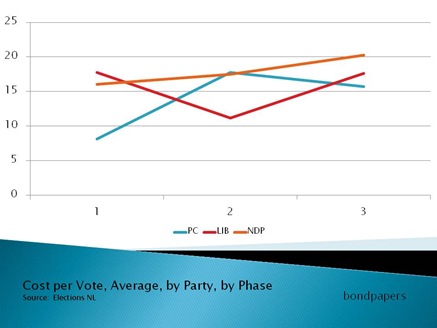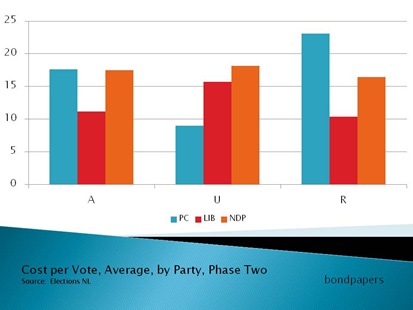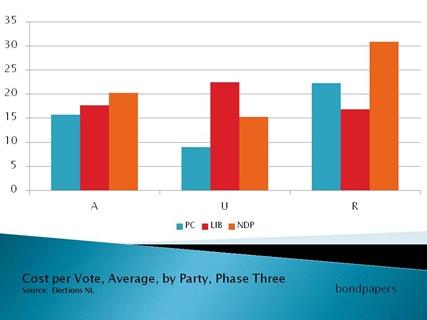In looking at by-elections in Newfoundland and Labrador, the second and third phases offer a neat cluster of by-elections in urban (metro St. John’s) and rural (everywhere else) districts.
Break those out and you get some information that shows the relative strengths and weaknesses of the parties, depending on where a by-election occurred during the period between 201 and 2011.
For starters, here is a reminder of the cost per vote results for the three major parties in all three time periods (phases).
Now let’s take a look at the second phase, that is, on the by-elections between the 2003 and 2007 general elections.
Three by-elections took place in what we can consider to be urban. They are Signal Hill-Quidi Vidi, Kilbride and Ferryland. The rural by-elections took place in Exploits, Placentia-St. Mary’s, Port au Port, Humber Valley, and Labrador West.
In the urban by-elections, the Conservatives average cost per vote was $8.98. The Liberals CPV was $15.71 and the NDP CPV was $18.17.
As much as we all assume that the New Democrats’ base of support is metro St. John’s, these CPV figures suggest otherwise. Now part of that high cost is attributable to the fact that the Tories hotly contested the seat when Jack Harris left for retirement in 2006.
But when you average the figure out the average cost per vote of the other two, you get $15.70. That almost exactly the same as the Liberals and their political infrastructure in the metro St. John’s area just shrivelled up to nothingness by 2007.
CPV is not a measure of actual effort of course. Parties in Newfoundland and Labrador don’t have to report all their efforts. Volunteer workers, for example, don’t show up as an expense in and of themselves. They show up when the party or the campaign has to foot their travel and accommodations bills.
That’s the kind of thing that happens to the Tories in rural Newfoundland. The Conservative Party itself spent more than $26,000 on campaign worker travel in the Labrador West by-election (2007). The by-elections in Ferryland and Kilbride cost the Tories only about $15,000 and $18,700 for example.
Labrador West essentially comprises two towns that are spitting distance apart. You would not have to spend $26,000 on travel unless you were flying people in from other parts of the province to work the by-election. Scan the by-election finance reports and you’ll see exactly the same kind of phenomenon in other Tory campaigns in rural Newfoundland.
Some call it “by-election-in-a-box” but what the Tories really do is maintain a team of campaigners they can drop into augment the local candidate’s effort. In addition, the Tories have a pattern of tapping into a regular pool of donors to help finance the given by-election. And again, it is part of a pattern of adding to the local campaign.
Contrast that with the Liberals, for instance. In any by-election, Liberal candidates are basically on their own. Sure there are some people who work by-election to by-election, and sure the party headquarters may toss some cash to a campaign.
But on the whole, Liberal candidates couldn’t count on the party for much of anything during the second and third phase by-elections. Two noteworthy exceptions to this were the Straits-White Bay North North and Terra Nova both of which took place in 2009 (Phase Three).
Incidentally, when people talk about the Liberal Party’s lack of organization and infrastructure, this is the kind of stuff they are talking about. This is the meat and potatoes of politics and the Tories know how to make a fine stew of it.
In Phase Three, you had three by-elections in the metro St. John’s are. Those are our urban set: Cape St. Francis, Topsail and Conception Bay East-Bell Island. The rural by-elections were in Baie Verte-Springdale, the Straits-White Bay North, Terra Nova and Humber West.
The Liberals’ urban cost per vote hit $22.50 in Phase Three. Spending dropped, on average, from about $9600 to a little under $7500 and the average vote went from 612 to $330.
NDP urban spending went from $14,412 to $11, 472 and the vote went from 793 to 751. The resulting CPV improved in Phase Three, reaching $15.27 compared to $18.17 in Phase Two.
The Conservatives CPV was $9.00. Their urban spending went up by about $2400 and the average vote went from 2370 (Phase Two) to 2741.
Conservative rural CPV dropped (marginally) from $23.07 to $22.25. Tory rural spending dropped by about $6,000 and the average vote dropped by 170 votes.
The New Democrats’ CPV in rural Newfoundland was $30.82 during Phase Three compared to $16.45 in Phase Two. The NDP increased their spending, on average by $1300 but their average vote dropped by 151. They spent 19% more, in other words, and got 36% less.
Liberal spending on rural by-elections increased by 70%, on average, in Phase Three compared to Phase Two. Liberal rural vote went up by four percent.
- srbp -


